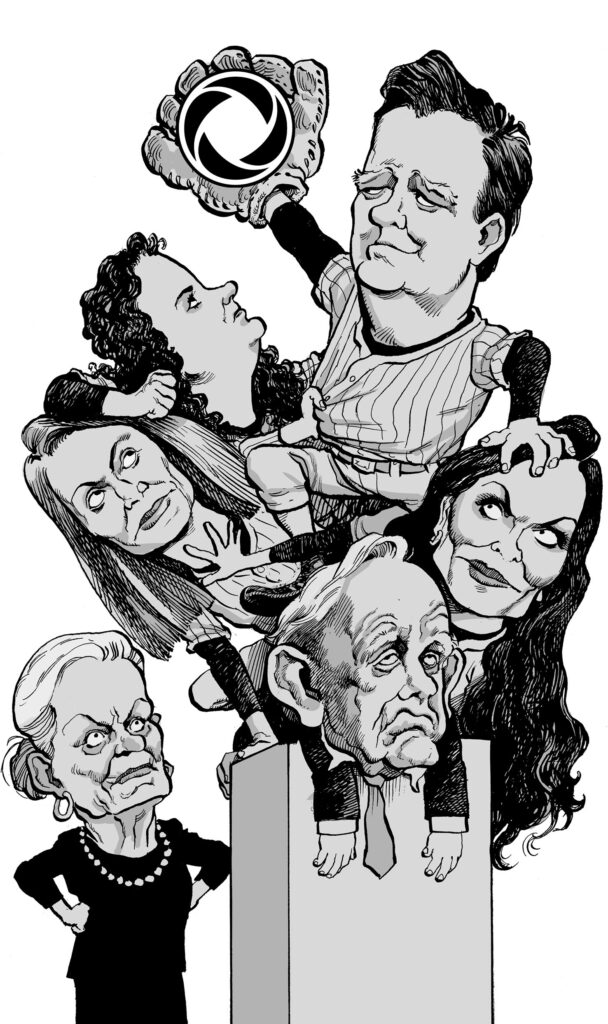Glimpsed from a distance, Toronto’s skyline provides a useful visual tableau, the background canvas for a telling portrait of a founder, his family, his firm, and their profound influence upon Canada’s technological and business landscape. Inevitably, a viewer’s gaze will be drawn toward the Rogers Centre, the iconic baseball stadium that sticks out as the most prominent physical acquisition and visible manifestation of the sprawling and ubiquitous telecom empire that Ted Rogers built over five decades as one of Canada’s most dynamic entrepreneurs and business leaders. After Ted purchased the Blue Jays in 2000 and then the SkyDome itself in 2004, the concrete building was renamed and quickly emblazoned on every side with the family firm’s corporate logo, in unavoidably gigantic, glowing red lettering.
Zooming in further, the Rogers Centre’s front plaza holds a twelve-foot-tall, 800-pound bronze statue — not of Joe Carter hitting his famous home run to win the 1993 World Series, or of any other heroic Blue Jays moment, but of Ted himself, a magnate whose only real connection to baseball was that he bought the team. Ted is smiling, wearing a suit and tie, holding some folders. Below him are four plaques, one on each side of his pedestal, that collectively provide a succinct summation of the man’s life:
Edward S. “Ted” Rogers 1933-2008
Founder, President & CEO, Rogers Communications 1960-2008
“The Best Is Yet to Come”
Visionary, Entrepreneur, Philanthropist, Passionate Canadian
In 2013, the statue was dedicated by his loyal and formidable wife, Loretta, with their children, Lisa, Edward, Melinda, and Martha, in attendance, along with dozens of Rogers employees, politicians, friends, and other courtiers. Instead of gracing the grounds of Rogers Communications’ corporate headquarters several kilometres away, the memorial occupies a very public (yet still private) space, a reflection of the dualistic way the family runs its affairs. The statue, its strategic location, and Ted’s relentlessly optimistic motto encapsulate the titanic ambition of an innovative, shrewd, and patriotic individual and his offspring. They also suggest, however unintentionally, the difficulties of securing an intergenerational business legacy, as well as the complications of power, control, and especially succession in a family firm.
After Ted, who? And how? In the wake of a highly publicized, somewhat tragic meltdown, is the best still yet to come for the Rogers firm and family, its customers, and Canada? For Edward, the victor in the recent brawl? What would Ted think of the mess his family got itself into?
The Rogers Centre statue does not feature in Rogers v. Rogers: The Battle for Control of Canada’s Telecom Empire, Alexandra Posadzki’s vivid and revealing portrait of Canada’s first family of telecom dysfunction. No matter: a journalist’s journalist and a business writer’s business writer, Posadzki delivers a riveting, rollicking exposé that provides countless other scenes to illustrate the family’s succession saga and its culmination. Beginning at Loretta’s deathbed, in 2022, and seamlessly running backwards and forwards in time, the Rogers story is all here, in all its compelling and sometimes sad and sordid detail: The legend of Ted’s rise and his pursuit of technology, business, wealth, and power. The daring deals and brutal boardroom battles. The betrayals and flame-outs. The butt-dials, social media scandals, and nationwide service outages. The corrosive clash of personalities and tales of vindictive personal retribution. Canada has had its share of billionaire family feuds — the McCains, the Billeses, the Stronachs — but few have been so devastatingly, shockingly broadcast to an entire nation in real time (ironically, Rogers’s own technological reach helped make that possible).

The costs of coming out on top.
David Parkins
As the Globe and Mail’s designated scribe on the Rogers beat during the 2021 power struggle, Posadzki produced near-daily, blazing reports based on hard-earned scoops. Now with Rogers v. Rogers, she offers a further reminder of what good long-form investigative journalism can accomplish by revealing the facts, foibles, and infighting behind one of Canada’s most interesting and impactful entrepreneurial stories. Given Rogers Communications’ immense and often intimate impact upon millions of daily lives, Posadzki provides a public service, one that not only unspools a good yarn but also does what the best and bravest journalism should do: speak truth to power. Drawing upon her extensive business writing background, her deep understanding of an essential, complex, and quickly evolving sector, her extensive secondary research and more than 100 interviews (including a brief one with me, on historical context), and her copious courtside observations and astute people-watching, Posadzki renders an indelible depiction of the Rogers epic.
The first segment of the book is a snappily drawn synopsis of well-known lore: Ted’s rambunctiously innovative rise, from his father’s early death in 1939 and the loss of the family radio business to becoming one of Canada’s foremost and far-seeing corporate leaders. Posadzki deftly paints Ted’s driving ambitions, his risk taking, his relentless faith in himself and his instincts, the health issues that plagued him, and, of course, the difficulties he had in coming to terms with questions of succession.
In these pages, Posadzki highlights the essential and sometimes overlooked role, both emotional and financial, that Loretta played in the tycoon’s career: “When Ted got the idea of going into cable, it was Loretta who personally paid the $225,000 down payment for the first 600,000 metres of cable to be laid.” Posadzki also analyzes the shifting postwar communications landscape, the role of regulation in the industry, and the dynamics of dual-class share structures, which figure prominently in many leading family businesses. She offers accessible assessments of several of Ted’s contemporaries in the cable, telephone, and media world as well, including Calgary’s Shaw family. From there, Posadzki nimbly jumps into more recent Rogers corporate history, which helps to contextualize the fracas that developed after Ted’s death and especially after the departure of his hand-picked successor, Nadir Mohamed, in 2013.
From this point on, Posadzki focuses upon the family’s public feud over the role of Ted’s only son, Edward S. Rogers III. Although he was passed over as the company’s chief executive in 2009, by birthright Edward chairs the family trust and is thus the controlling shareholder of Rogers Communications through its dual-class shares. In 2021, Edward’s unilateral decision to replace Joe Natale with Tony Staffieri as CEO sparked a boardroom revolt, led by his mother and sisters. As the debacle played out in the headlines and in the courts — with appearances from corporate heavyweights and a who’s who of Toronto’s power brokers, including the mayor, John Tory, a long-time family friend — Canadians were captivated by the drama, if not unwillingly captured. Looming over all this conflict was a massive, convoluted $26-billion merger in the works with Shaw Communications, a deal that would cement Ted’s dream of building a truly national telecom giant. All the while, non-voting Rogers stock, held by so many Canadians directly or indirectly, rolled up and down. Eventually Edward got his way and his Shaw merger.
Despite the sometimes complicated corporate narrative and the large cast of characters, the level of detail and insider knowledge exhibited in Rogers v. Rogers makes for a genuine page-turner. This is a bona fide soap opera, written with the appropriate tempo, characterization, and staging to make it screen-worthy — a real-life analogue, as so many have remarked, of Succession. Like the HBO show, the Rogers story is one of wealth, power, family, and the moral ambiguity of capitalism. Importantly, Posadzki’s even-handed but firm brush strokes give her Rogers canvas an open-ended quality, one that allows readers some leeway in deciding for themselves who the villains (or heroes) in this picture are and why.
The vibrancy of Posadzki’s portrayal almost obscures what is perhaps the only aspect of Rogers v. Rogers that could be improved upon: there are no visuals in the book, of any kind. No doubt there was urgency to get this tale into print without the costly and complicated delay of adding artwork. But it’s also true that having images of the people, places, and remarkable incidents that animate the narrative would have added to Posadzki’s comprehensive characterization. Why not include a shot of Ed’s wife, Suzanne, and her infamous tone-deaf Instagram post of the family at Mar-a-Lago with Donald Trump during the pandemic, which caused justifiable outrage? Perhaps a screen grab from the equally infamous Cameo video message that Suzanne commissioned from the Succession star Brian Cox, who congratulated Edward on his boardroom victory and “also having [told] Joe Natale to fuck the fuck off” (a story that Posadzki broke)? Or maybe reproductions of Martha Rogers’s raw, indignant tweets denouncing her brother and his cronies? In a book replete with wonderfully written scenes, a few pictures would have added some nice finishing touches.
Ultimately, the focus of Posadzki’s dramatic family portrait settles upon its main subject, Edward. What we discern is not flattering. Nicknamed “Edward the Accountant” by his father, he comes across as obsessively focused on finances and the bottom line, even if he’s sometimes inconsistent and somewhat lacking in judgment. He is described by some as treating the publicly held company “like his own private fiefdom.” Others recall him looking down on the executives who manage the organization as “merely the hired help.” As Posadzki suggests, there is a ruthlessness to his actions that seems unnecessary. We see in Edward someone who was willing to defy his mother, spurn his sisters, and push his family to the brink, all to control an empire. Like Succession’s Logan Roy, Ted recognized the essential problem; neither patriarch was able to effectively solve it.
Indeed, one wonders what Edward would think if he were to pick up and read this profile of himself and of the Rogers clan. Perhaps he has read it already but counts on the benefits of oligopoly and entitled wealth that shield him from the consequences of questionable decision making. And if the share price continues to do well, all the turmoil his actions caused will be forgotten. He will be vindicated, if not absolved. And if he hasn’t read it, perhaps one day he will — and realize that there’s only one statue of a Rogers in front of the old SkyDome for a reason.
Dimitry Anastakis recently wrote Dream Car: Malcolm Bricklin’s Fantastic SV1 and the End of Industrial Modernity.

